Articles and News
SPRING FASHION FORECAST, PART II: MORE TOP TRENDS AND WHAT IT ALL MEANS TO JEWELERS | October 05, 2011 (2 comments)
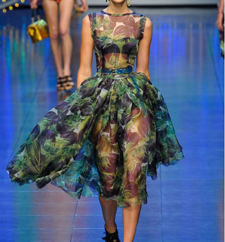
Merrick, NY—With the spring/summer ready-to-wear shows in Milan just completed and Paris’ underway, the key trends emerging build upon what was shown in New York and London (see The Centurion’s earlier report here) and bring in some fresh takes on both sleek, sharp 1950s dressing and 1920s flapper styles. The standout jewelry piece was undeniably the earring.
In Milan, the dress made a strong showing, with the two primary silhouettes being the slim, dropped waist flapper style of the 1920s, or a neat, nipped-waist, fuller-skirted 1950s style. The skirt itself also is important, whether full and swingy or in slim, long-line pencil styles. Prints and color, both important in New York and London, remain strong. In Milan, color is bolder than in Paris—there, lighter and more ethereal pastels rule—but Milan’s print of choice is the classic scarf print. The peplum jacket also showed up strong and the sports influences seen in New York (baseball jackets, scuba stripes) were interpreted as sporty blousons and bombers in Milan.
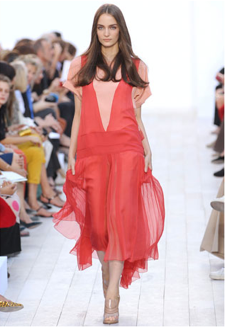
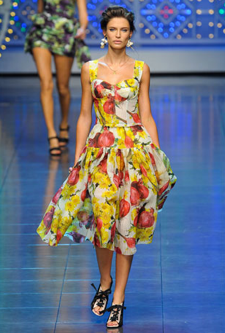
Left, the dropped waist and floaty layers of Chloe's dress evokes the flapper, while the 1950's suburban housewife might prefer this Dolce & Gabbana full-skirted print dress, worn with strong earrings, right. Pinks, yellows, and oranges (below) will be important colors for spring 2012. Photos: Imaxtree for Harper's Bazaar.
Orange is big color news, and the entire palette from yellow through orange into the pinks was strong. Blues and greens still are present, and icy pastels are as equally important as bold color. Finally, those who fear color shall have no fear: black and white remains an important option, with zebra being the classic animal pattern of choice for spring.
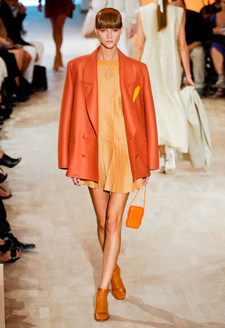
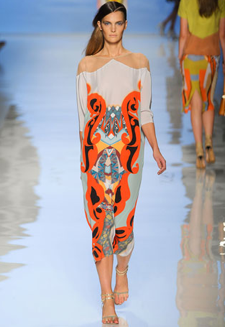
Orange is shaping up to be a key color for spring/summer 2012. At left, not surprisingly, Hermes embraces its signature color, while at right, Etro's take on a few trends at once: an orange scarf print in a long, lean look reminiscent of the Roaring 20's. Photos: Imaxtree for Harper's Bazaar.
What it means to you. Here’s what jewelers need to know about merchandising for the spring/summer ready-to-wear trends:
- The earring was the standout jewelry category. Big earrings were very important on many runways. Drop styles in a variety of silhouettes were shown, though overall the look was more elongated than wide--think clusters and wind chimes more than chandeliers.
- Cuff bracelets and bold wrists also remain important. For women who like a bit more flexibility than a rigid cuff, a big stack of slim bangles gives an equally bold look, with the added advantage that the customer can keep coming back for more and she doesn’t have to commit to everything at once.
- The cross just won't go away as a motif. Not as prevalent as statement earrings or cuffs, it nevertheless made a showing at Pucci and Lanvin.


Crosses showed up long at Lanvin, left, or wrapped around the neck at Pucci, right. Photos: Imaxtree for Harper's Bazaar.
- Flapper style dresses are a natural very long necklaces. This has been trending in fine jewelry already, so jewelers who haven’t bought the look may want to consider adding it in. Tassels are good here too. Long earrings also go well with this lean, languid look—or a big on-ear earring works with a cloche hat or turbaned scarf, both equally Daisy Buchanan-esque.
- The Roaring Twenties also mean Art Deco. A perennial favorite period for fine jewelry, it works beautifully with the neo-Deco influences we’ll see for spring, and the black/coral combinations of the period will work beautifully with spring’s orange-y shades. Jewelers with important estate departments may want to look for some Deco period pieces—it’s both timeless and current.
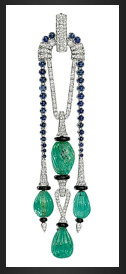
Art Deco jewelry is a natural for spring's flapper-inspired fashions. Photo: Farlang.com.
- Incidentally, as a note of interest, Art Deco also is the design period that’s been most influential for today’s bridal jewelry trends.
- Fifties-style dresses are a perfect foil for estate jewelry of that period. An advantage for jewelers is that estate pieces are not something that can be shopped: it’s got the same kind of “buy it now” urgency as a flash sale, minus the deep discount. The fashionista who wants something unique and one of a kind will love this idea—and a piece of this period also is likely to be less costly than a Deco piece. Try suggesting a cool brooch—it’s just the kind of funky odd thing we can see style setters like Sarah Jessica Parker or Chloe Sevigny homing in on. Click here to see how Krombholz Jewelers in Cincinnati, OH catches onto this trend!
.png)
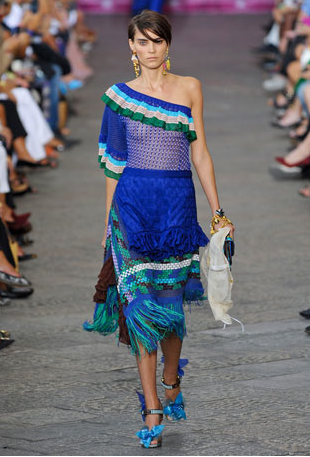
In this look from Marni, left, the drop-waisted 20's flapper sports bold cuffs at the wrists (both), as well as statement earrings. At right, Missoni also shows a strong earring, and proves that blue and green still have staying power. Photos, Imaxtree for Harpers' Bazaar.
- Explore warm-toned gems that work with an orange palette: mandarin garnet, fire opal, citrine, yellow sapphire, golden pearls, smoky quartz.
- Black and white remains important for jewelry as well as clothes. Mixes of black and white pearls, black and white diamonds, or black and white enamel on white metal are some options here, and black diamonds, especially, can help take a classic look to a more casual and wearable level, keeping it from getting too precious.
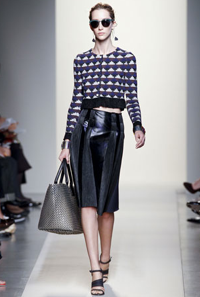
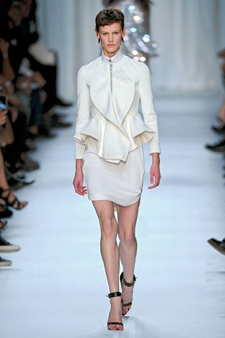
Left: Bottega Veneta goes more '50s than '20s. Black and white remains and important classic, and here, note the statement earrings again. Right, as in New York and London, the peplum was important in Milan and Paris. Photos, Imaxtree for Harper's Bazaar.







